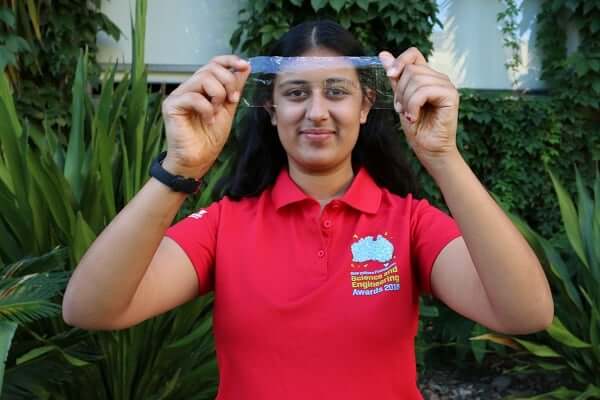Would you say it is possible to make a pliable substance from the hard shells of prawns? Plastic seems so essential to all aspects of our life today but its ubiquity has become the bugbear of every person concerned about its environmental impacts. Is it ever possible to find a replacement for plastic that is eco-friendly?

Fifteen-year-old Year 11 student of Sydney Girls High, Angelina Arora, has managed to do both of this. She will soon be on her way to the Intel International Science and Engineering Fair in the USA where over 1,800 high school students from 75 countries, regions and territories are given the opportunity to showcase their independent research.
This journey has been made possible as Angelina is one of six prestigious winners of the 2018 BHP Billiton Foundation Science and Engineering Awards. The awards are a partnership between the BHP Billiton Foundation, Commonwealth Scientific and Industrial Research Organisation (CSIRO) and country-wide Science Teacher Associations (STA). Since 1981, these awards have been supporting pioneering research of young people in STEM (Science, Technology, Engineering and Mathematics) subjects.
Other amazing winning inventions this year includes a bionic arm that can detect and disarm landmines without putting human lives at risk, a picnic rug that repels ants, a biochar product that can filter water and also be used as a fertiliser, a flood warning device and a robotic window cleaner.

Indian Link spoke to Angelina at the national camp of top 26 finalists of these awards where she participated in a series of lab and science activities and presented her project to judges. “I tested the strength, elongation, clarity, solubility, deconstruction and endurance of the plastic that I created from prawn shells and protein from the cocoons of silkworms, as well as other plastics made out of potato, corn and tapioca,” said Angelina, launching straight into the details of her creation. Angelina said that she was first made aware of the harmful effects of plastics when a shop attendant said that she had to pay for the plastic bag, which until then was given for free. The attendant explained that it was because plastic was bad for the environment and we need to reduce its use. This was trigger enough for Angelina’s questioning bent of mind.
She delved further into the extent of ill-effects of plastic and found that plastics have now found their way into the oceans and the creatures that live in water. As seafood consumers, humans are not far removed from ingesting plastics indirectly, she learnt.
Angelina wanted to find a sustainable alternative. With support of her school teachers, a lot of experimenting – and patience! – Angelina was ready to present her findings.
The first part of her project was to examine different breeds of fish for micro-plastics, for toxics that leach from plastics into their flesh and enter the human food chain. The second was to research options for bioplastics made from starches extracted from corn, potato and tapioca which would be environment-friendly as they return to nature when they disintegrate. Current plastics made from petroleum products stay intact in nature for hundreds of years, even after they disintegrate.
Angelina’s initial experiments led to her picking up the first prize in chemistry in her age bracket at the STANSW Young Scientist Awards 2016. As a result, she was introduced to top scientists at CSIRO who are now mentoring her through her current project of turning discarded prawn shells into bio-plastic. The spur for this idea was a visit to her local fish and chip shop and the sight discarded piles of crab and prawn shells, smelly and destined for the bin. Surely there had to be a better, more sustainable way of disposing them, thought Angelina. So she took some of this waste to her school lab and began experimenting.

“Prawn shells consist of a hard yet flexible protein called chitosan. I combined this with fibroin, another sticky protein extracted from the silk of silkworms. This shrimp plastic was sturdier than the corn-starch bioplastic I made from plant sources. It does not disintegrate in water. And when it finally disintegrates, it doesn’t leave harmful substances in nature. In fact, it can act as a fertiliser for plants,” explains this young scientist. “Right now, I have got offers for developing this product commercially for packaging products.”
Angelina has, in fact, been declared the winner of the Innovator to Market award for the 2018 BHP Billiton Foundation Science and Engineering Awards and this will make her research a practical reality. She hopes this new plastic could replace plastic shopping bags and other packaging to reduce the environmental impact on landfills and oceans.
Angelina acknowledges that she couldn’t have done this all alone. “I am lucky to have people in the CSIRO and Sydney University, my parents and school science teachers to guide me,” she says. Time management seems easy for this young lady who balances inventing, school work, swimming, cricket, playing the clarinet and piano, public speaking, dance, drama and volunteering.
Angelina says she hopes to be a role model for other young girls considering a career in science. “I am not sure if I want to be a doctor or an environmental engineer yet. All I know for now is that I would like to help people and nature,” she says, revealing the mind of a confused teenager, just this one time.
PLASTIC 2.0

- Prawn shells consist of a hard yet flexible protein called chitosan. Angelina combined this with fibroin, another sticky protein extracted from the silk of silkworms.
- It is sturdier than the corn-starch bioplastic Angelina made from plant sources. It does not disintegrate in water.
- When it finally disintegrates, it doesn’t leave harmful substances in nature. In fact, it can act as a fertiliser for plants.
- Angelina has got offers for developing this product commercially for packaging products.



